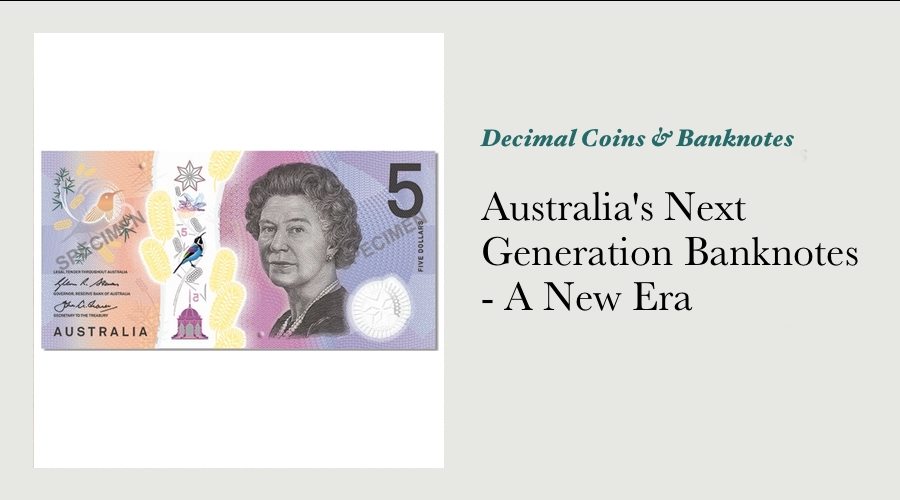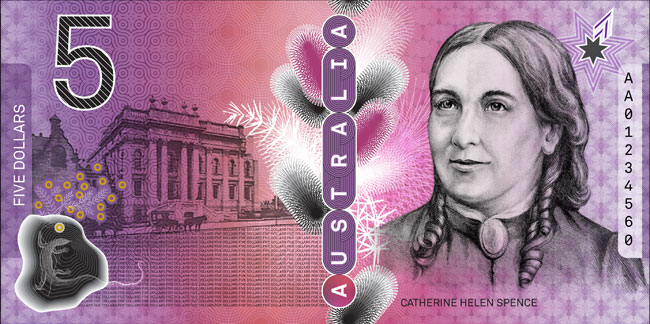Australia's Next Generation Banknotes - A New Era

New $5 Banknote
The release of the designs to be used on a new $5 banknote to be introduced into circulation in Australia in September 2016 took social media by storm - there was no shortage of keyboard warriors foaming at the mouth about whether the Queen should still be on an Australian banknote, and just how (apparently) unattractive the designs were!
As much as the titans of social media would like to think otherwise, the designs were arrived at after a long and considered process, and is just one stage in what the Reserve Bank of Australia (RBA) is calling the Next Generation Banknote (NGB) Project. Although this project was formally announced in September 2012, work on a revised series of Australian currency notes was formalised in 2007, and is thought to have started at least 12 months before that.
So Australia’s new $5 note was at least a decade in the making, and we’d have to be crackers to think that at no stage during that period, not one person in a focus group would have said “Hey, those yellow flowers on the back of the note are pretty bright!”
There are a number of aspects of the Next Generation Banknote (NGB) Project that are of interest to collectors, and rather than pile them all into one long article, I’m going to break them down into a series of smaller articles:
1. Australia’s Next Generation Banknote Project - Background, Budget and Timeframe;
2. Australia’s Next Generation Banknote Project - New Security Features;
2. Australia’s Next Generation Banknote Project - Connor McLeod and the New Tactile Banknote Features;
3. Australia’s Next Generation Banknote Project - Apparent Controversy in the Designer Selection Process;
4. Australia’s Next Generation Banknote Project - the Machine Readiness Program.

Background, Budget and Timeframe
A number of press releases from the RBA since the NGB Project was announced have pointed towards research that shows that banknotes around the world tend to have a life-cycle of around 7-10 years. Counterfeiting technology progresses over time of course, and that 7-10 year period is as long as most governments and issuing authorities around the world are prepared to wait before taking preventative steps to ensure the public’s confidence in the national currency isn’t dented by sporadic outbreaks of counterfeit notes being passed, no matter how poor those counterfeits might be.
Australia’s notes really are the exception to the rule however - we know that our current (and first) series of polymer notes was issued in stages between 1992 and 1996, which means they’ve lasted for more than 20 years - between double and triple the average lifetime for notes from other countries around the world.
Despite the built-in security that our polymer notes have, a concerted attempt in by a Mexican criminal organisation to counterfeit the (polymer) Mexican 50-Peso note may have been the cue for the RBA to get cracking on the long-term project of upgrading our national currency.
The first counterfeit Mexican polymer notes were identified in June 2010, and over the next two years, no less than four different types of counterfeit polymer 50 Peso note were sighted in circulation. Each series of counterfeits had apparently had been printed significantly better than those printed previously. Mexican Federal Police arrested four people in November 2012, at which time 220,000 counterfeit notes were eventually seized, for a total face value of around A$1,000,000.
This attack on Mexico’s polymer notes came off the back of a concerted attempt by a cartel in Colombia to counterfeit the Australian polymer $100 note - Australian Federal Police were confident they’d seized the entire print run of the notes before they could be shipped to Australia, however just that batch alone had a face value of A$5,000,000.
The rates of counterfeit notes in Australia are extremely low when compared to other countries - experts have determined that Australia has had between 8 and 12 counterfeit notes per million notes in circulation over the past decade or so. To put that figure in perspective, the UK has apparently recently had as many as 220 counterfeit notes per million in circulation…
Even though the rate of counterfeit notes in Australia remains quite low, the total dollar value perhaps isn’t as innocuous - the total value of counterfeit Australian notes seized across 2013 and 2014 came to A$1.083 million - no small amount of money at all.
Replacing a national currency is no small job of course, particularly when it comes to developing the technological features that are needed to stay in front of the ever-opportunistic counterfeiters around the world in the 21st century. The complexity of the task of upgrading our national banknotes is such that it needed a decent lead time before it could be implemented.
When news of the NGB project was made public by Adam Shand in the Australian newspaper in September 2012, much was made of the fact that the NGB project was “over budget” and “behind schedule”. The RBA issued a press release in response that morning, and another the next day. Both press releases pointed out that “Considerable work has already been undertaken on this project, including the development and review of banknote designs and production trials of new security features. But it is important that the new features are rigorously tested, durable, and effectively incorporated into the banknote designs. The Bank will also consult extensively with relevant stakeholders to ensure that Australia's banknotes continue to meet community needs. As such, it is anticipated that it will be several years before the first of the upgraded banknotes will be issued. Other denominations will be issued progressively in subsequent years.”
Under questioning in an Australian Senate Standing Committee on Economics session in February 2013, RBA staff understandably disagreed, and stated that: “The Next Generation Banknote (NGB) project is not behind schedule. While there are indicative dates for completion of various stages, these dates were always intended to be subject to review as the project progressed. The need for flexibility in the program reflects the complexity of the process of designing and developing a new banknote.”
Regarding the question of whether the NGB Project was over budget, RBA staff stated: “The preliminary budget for the development of the NGB series is around $25 million, of which around $10.5 million has been spent to date on design, development and testing… The final budget will depend on the number of trials conducted and the extent of public education required.”
While we all know that there can be a lot of waste in certain government departments, however the explanations provided above certainly appear to be reasonable.
Regarding the timeframe for the remainder of the NGB Project, the RBA has announced that the first Next Generation note to be released is the $5 note, which will be put into circulation on September 1st 2016. Each of the other denominations will be released over a period of time, perhaps one per year for the next 4-5 years.
So there we have it, Australia’s Next Generation polymer banknotes are being printed even as we speak - they’ve been the subject of a careful design and testing process, are within budget, and on schedule.